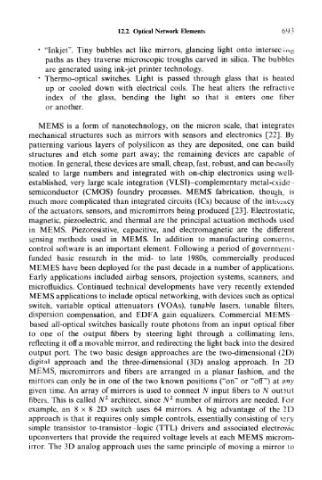Page 709 - Introduction to Information Optics
P. 709
12.2. Optical Network Elements 693
• "InkJet". Tiny bubbles act like mirrors, glancing light onto intersecting
paths as they traverse microscopic troughs carved in silica. The bubbles
are generated using ink-jet printer technology.
* Thermo-optical switches. Light is passed through glass that is heated
up or cooled down with electrical coils. The heat alters the refractive
index of the glass, bending the light so that it enters one fiber
or another.
MEMS is a form of nanotechnology, on the micron scale, that integrates
mechanical structures such as mirrors with sensors and electronics [22]. By
patterning various layers of polysilicon as they are deposited, one can build
structures and etch some part away; the remaining devices are capable of
motion. In general, these devices are small, cheap, fast, robust, and can be easily
scaled to large numbers and integrated with on-chip electronics using well-
established, very large scale integration (VLSI)-complementary metal-oxide--
semiconductor (CMOS) foundry processes. MEMS fabrication, though, is
much more complicated than integrated circuits (ICs) because of the intricacy
of the actuators, sensors, and micromirrors being produced [23]. Electrostatic,
magnetic, piezoelectric, and thermal are the principal actuation methods used
in MEMS. Piezoresistive, capacitive, and electromagnetic are the different
sensing methods used in MEMS. In addition to manufacturing concerns,
control software is an important element. Following a period of government-
funded basic research in the mid- to late 1980s, commercially produced
MEMES have been deployed for the past decade in a number of applications.
Early applications included airbag sensors, projection systems, scanners, and
microfluidics. Continued technical developments have very recently extended
MEMS applications to include optical networking, with devices such as optical
switch, variable optical attenuators (VOAs), tunable lasers, tunable filters,
dispersion compensation, and EDFA gain equalizers. Commercial MEMS -
based all-optical switches basically route photons from an input optical fiber
to one of the output fibers by steering light through a collimating lens,
reflecting it off a movable mirror, and redirecting the light back into the desired
output port. The two basic design approaches are the two-dimensional (2D)
digital approach and the three-dimensional (3D) analog approach. In 2D
MEMS, micromirrors and fibers are arranged in a planar fashion, and the
mirrors can only be in one of the two known positions ("on" or "off") at any
given time. An array of mirrors is used to connect N input fibers to N output
2 2
fibers. This is called N architect, since N number of mirrors are needed. For
example, an 8 x 8 2D switch uses 64 mirrors. A big advantage of the 2D
approach is that it requires only simple controls, essentially consisting of very
simple transistor to-transistor-logic (TTL) drivers and associated electronic
upconverters that provide the required voltage levels at each MEMS microm-
irror. The 3D analog approach uses the same principle of moving a mirror to

